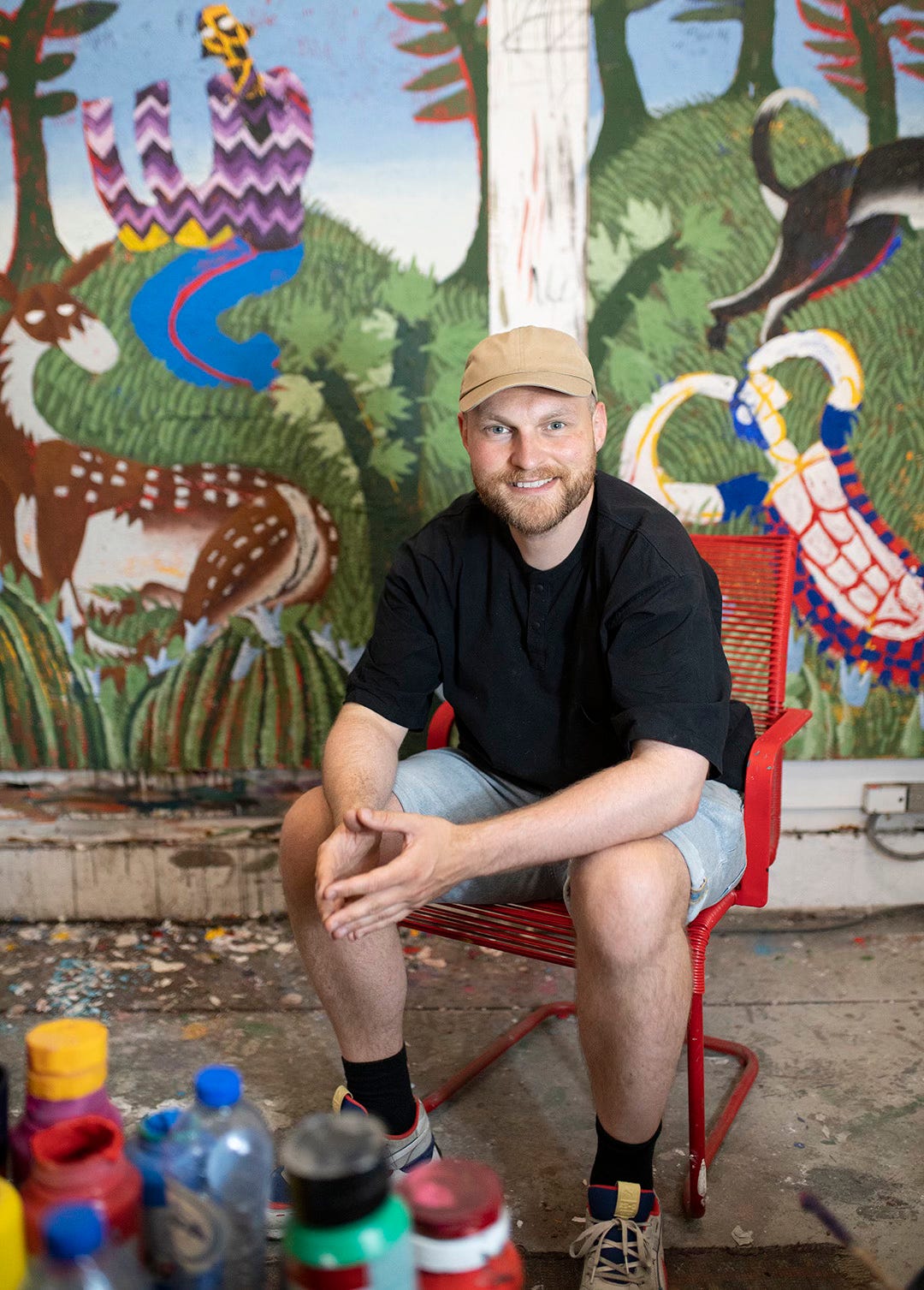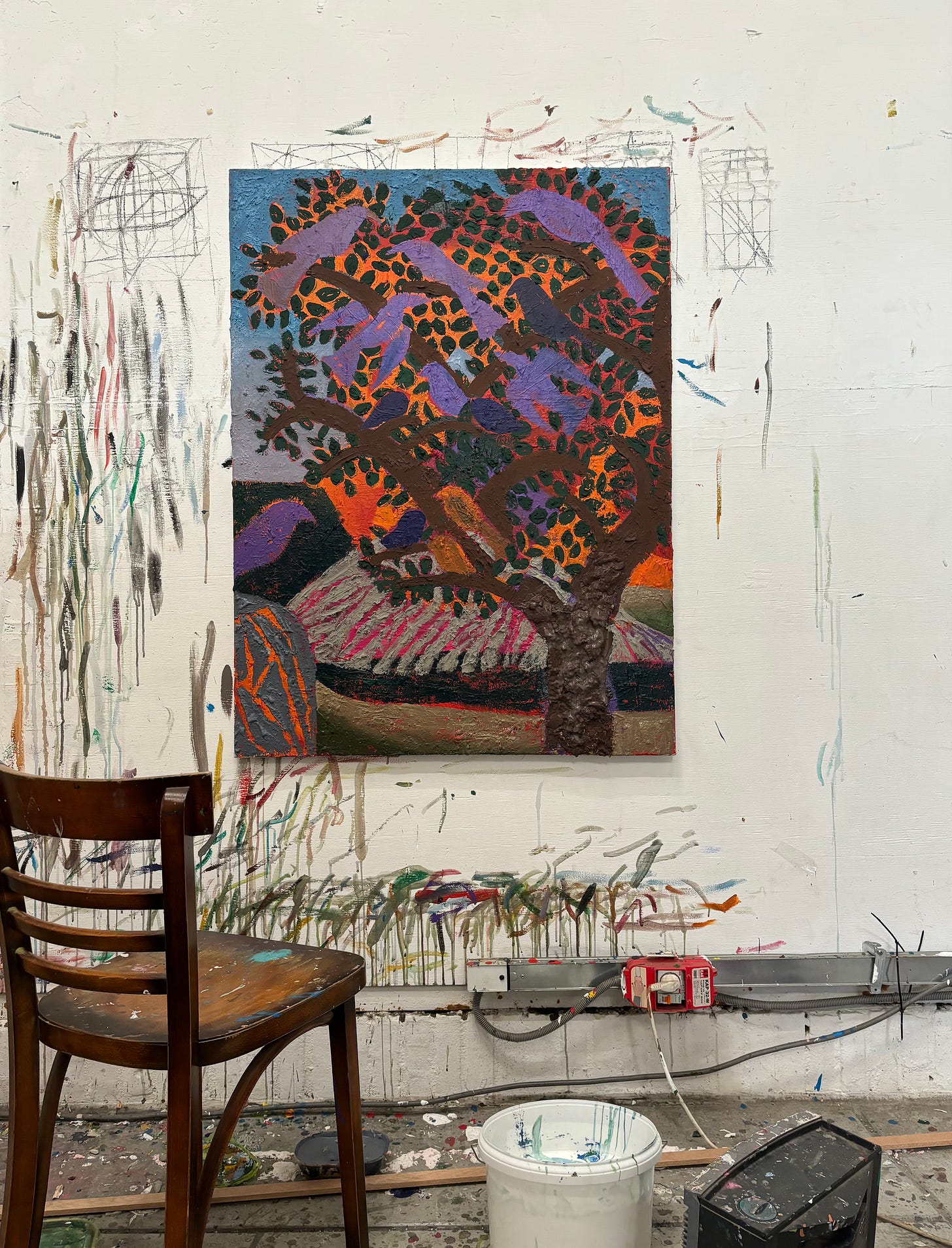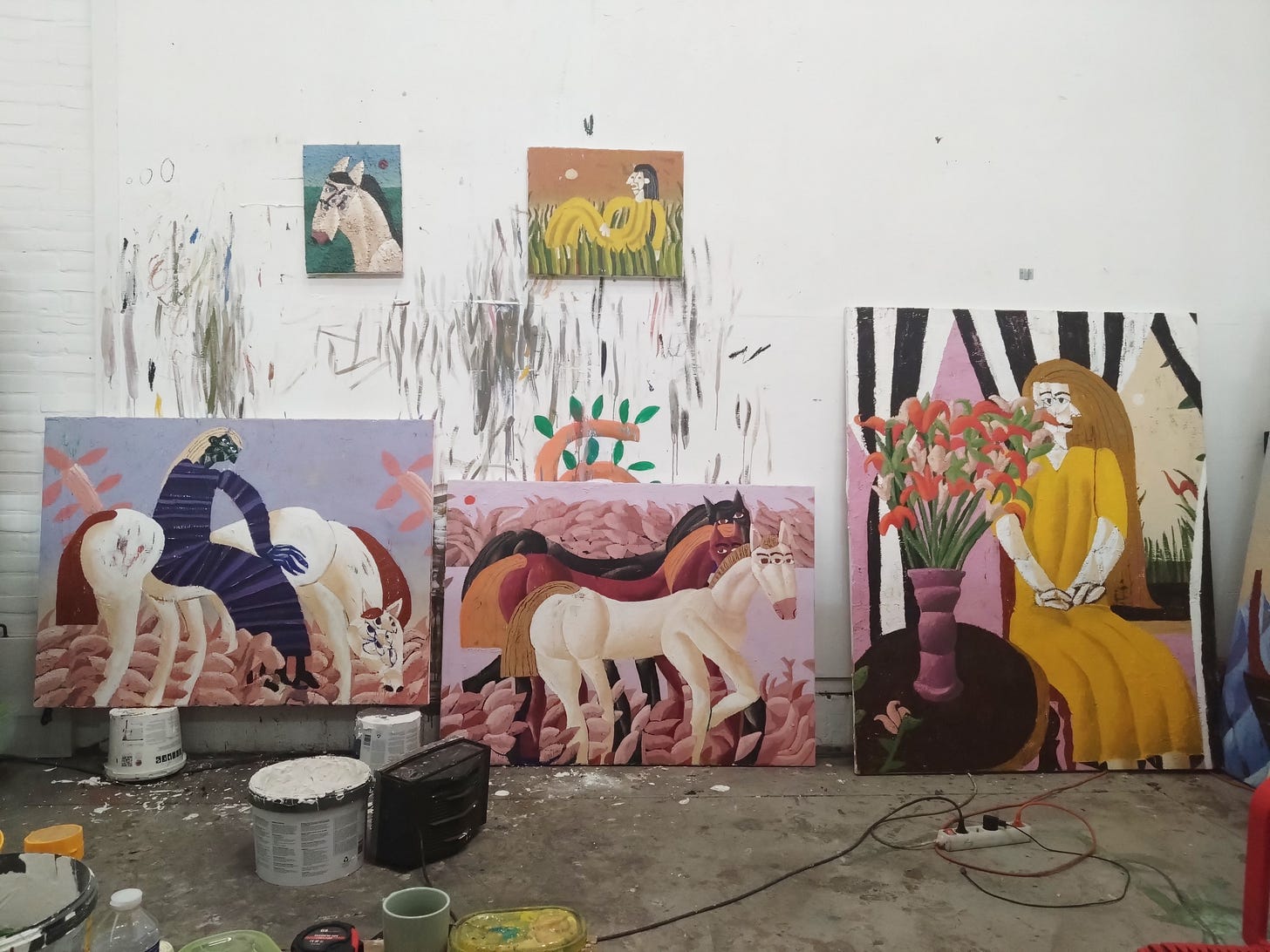Ralf Kokke
The artist discusses growing up in Rotterdam, the roots of his romanticism, and the gift of making art.
Ralf Kokke graduated from the Royal Academy of Fine Art, Antwerp with a BFA in Painting in 2014. Solo Exhibitions include Hooked On Neverland, Kristin Hjellegjerde Gallery, London (2023) Wild Roars in Calm Corners, Nino Mier Gallery, Los Angeles (2023); Between A Rock And A Hard Place, Hans Alf Gallery, Denmark (2021); Art Rotterdam, Mondrian Fund, Concepts and Prospects, Rotterdam, Netherlands (2020). Group Exhibitions include In Momentum, Kristin Hjellegjerde Gallery, London (2021) among others.
In 2020 Ralk Kokke was awarded a grant from the Dordrechts Museum, Dordrecht, Netherlands. In addition, Kokke was invited to a number of residences including a Residency at Van Gogh-Huis, Zundert, Netherlands in 2020. Kokke’s works can be found in important private and public collections which include the Dordrecht Museum collection and Van Gogh Huis collection.
Mepaintsme: It’s interesting, given your background of growing up in Rotterdam, that your work is so rooted in Romanticism. Is there anything to read into there?
Ralf Kokke: My upbringing in Rotterdam is somehow related to my paintings, but mostly in a personal sense. I was a kid who had difficulties differentiating reality from fantasy — I had vivid dreams and nightmares, and my memory didn’t discern what really happened from what didn’t. I grew up in a Protestant school where we had to write down psalms every Friday. Next to these psalms, we were instructed to draw pictures about them, but I drew pictures of tornadoes and aliens. My teachers didn’t like this at all and failed me in this lesson — I had to depict what was written in the psalms. This is the moment I started to draw these romantic pictures of paradise, Neverland and dream-like worlds. Listening to these stories and drawing these worlds made me more grounded, and I felt more stable. For me, these psalms woke up that "romantic" part of me.
MPM: Interesting that such an early experience opened up your romanticist tendencies!
RK: It is funny because I just noticed this within me. A year ago, I got my psalms from the attic, and what was so mesmerizing is that my current style of depicting figures isn’t that different from what is drawn in that book.
MPM: One thing I love about your work is its dialogue with abstraction. Was there a period where your paintings were purely abstract or was this early figuration always central to your work?
RK: Figuration has always been central. I think this dialogue with abstraction stems from my deep love for the craft of painting. I read about painting techniques almost every day. Sometimes, I explore how to apply fillers to paint, other times I'm looking for specific recipes to make my paint, and occasionally, I delve into color theory or study composition theories. What I appreciate about the craft of painting is the endless knowledge that has been built up by many painters before us. I use these sources that have accumulated over decades and centuries of painting.
When I consider my relationship with abstraction, it mostly stems from these studies. I try to understand how we look at things, and in which direction I want the viewer to be guided. I always ask myself, what is the story I want to tell? The abstracted squares and lines I use in my understudy paintings are not just aesthetic; they are also practical, dictating the direction and placement of my figures. Another practical consideration for me is color. Working on a cold, white surface is extremely difficult for me; when I do, I tend to use too much white in the end. So, I’ve found I need to work with colors underneath my top coat of paint. Most of the time, I use complementary colors under the top coat ones, to add extra layers that work well together.
MPM: I see the earliest incarnations of cubism lurking about your work. Do you find the early modernists to be inspirational? How about contemporary artists?
RK: I love modern cubist and expressionist paintings. Some of my favourites are the ones from the Flemish expressionists like Frits Van Den Berghe, Constant Permeke and Gustave Van De Woestijne. For me, cubism represents movement. The images are painted in such a way that you create the movement yourself in your mind. For me, Cubism also resonates with the socialist movements of Europe. The imagery of elegant court life and the portrayal of the industrially rich bourgeoisie gave way to square-shaped labourers. The way early cubist painters depicted ordinary folks—hookers, laborers, street vendors, etc. — this is what normal people look like, square shaped, out of proportion, marked by hard life, and there's no denying it. I love this directness and characterization of the bodies they portray.
MPM: I’ve never read a connection between the formal aspects of Cubism and class distinctions. These interpretations are more personal for you?
RK: I recognize these things from the neighborhood where I grew up, in the suburbs of Rotterdam. People don’t have beautiful, soft skin; it’s wrinkly, and the bodies are pear-shaped or squared, each of them tells a story; sometimes these aren’t pretty stories, but that is the beauty of cubism and expressionism. I can’t look away from some of the stories that are facing me.
MPM: I’m curious - what kind of schedule do you keep in your studio? Are you a morning painter or a late night painter?
RK: I am definitely a morning person. I wake up at 6 AM and go straight to work, returning home around 7 PM. The first thing I do in the morning is spend an hour reading about painting. Currently, I am reading The Artist’s Handbook, by Ralph Mayer. I've learned so much practical knowledge about keeping my paintings durable and understanding how pigments and colors work. After my first cup of coffee, I draw something, usually inspired by what I dreamt the night before. Then, I handle emails, accounting, or work on my gallery side project, Tinimini Room (Dordrecht), depending on the day. Once these tasks are done, I go to my studio, get my writing book, and write about my paintings. I always write about my paintings before I start painting. I describe, as well as I can, what I see in my mind's eye: the colors I want to use, the composition, the subject, the order of tasks, and what I need to finish that day.
MPM: That’s sounds like a pretty tight routine.
RK: That’s because I am the most chaotic person I know, and I need to balance it out by being very orderly. So, I take a lot of time management courses to make my life easier. Interestingly, working time for me is not only about painting but also about preparation, studies, and distance as well.
For me, the practice of being an artist is about working 60-70 hours a week, not seeing many people, painting for long stretches, and reading a lot about the craft and history. And it needs to feel natural for me to do these things, while trying not to feel too sorry for myself if things aren’t going as planned. If something works out, I continue. If it doesn’t, I have to take the next opportunity and try to keep my head high. Every show I have on my schedule is a gift. If there is nothing on my schedule, I have to make sure to make my own show, or organize my own projects. This way, I am prepared to work hard, but at the same time expect to get little, while still finding joy in it and not feeling sorry for myself if things aren’t going as planned.
MPM: I feel the importance of an artist’s work ethic is something only understood by other artists. Most people just equate it to leisure and not real work from my experience.
RK: Being an artist is the most blissful thing to do. I can remember working in a factory, in a hospital, as a post deliverer, and as a dishwasher. I can tell you, this life as an artist is still better. I have loads of respect for the group of laborers who never complain and continue to work even when times are tough, often forminimum wage. I remember meeting factory workers without fingers, with vascular disease (because of the long night shifts), working double shifts, and trying to make the most of every working hour to earn a bit of money. Really, nobody stands up for this crowd. But those days are, for me, for now, are over, and ever since, I feel like every day is a blessing.
MPM: Do you listen to music while you work? I like to put together a playlist of what you’re currently listening to while in the studio (music or podcast).
RK: Oh, I don't really work with music. I do wear earplugs, sometimes, just to cancel out noises, haha. But recently, I've gotten into this channel called Dead Tempo Visions, which focuses on liminal horror. The images remind me of things I saw when I was a kid. So, I'm not only obsessed with liminal spaces nowadays, but I also listen to the music that this channel uses in its videos. They feature music from Castle Hearts. In my free time, I also listen to the Moomins theme song, which I'm using for my upcoming project on Instagram. I'll post a drawing from my nightmare tales and use one of Graeme Miller's songs from the soundtrack of the Moomins.







